Youth Winter Sports
Lean about youth winter sports such as what to wear, skating, skiing, snowshoeing, and hockey.
If one is fortunate enough to live in a part of the country where they have old-fashioned winters, the possibilities for outdoor sports are very great and the cold weather may be made the best part of the year for healthful outdoor exercise. To enjoy winter recreations properly we must have proper clothing. An ordinary overcoat is very much out of place, except possibly for sleighing. The regulation costume for almost any outdoor sport in winter is a warm coat, a heavy sweater, woollen trousers and stockings, and stout leather shoes. If in addition we have woollen gloves or mittens and a woollen skating cap or toque, we shall be enabled to brave the coldest kind of weather, provided of course that we have warm woollen underwear. Various modifications in this costume such as high hunting boots, or leggings and a flannel shirt worn under the sweater are possible. In the far North, the universal winter footwear is moccasins. We must be careful not to dress too warmly when we expect to indulge in violent exercise. Excessive clothing will render us more liable to a sudden check of perspiration, a consequent closing of the pores and a resulting cold. Rubber boots or overshoes are very bad if worn constantly. The rubber, being waterproof, holds in the perspiration and we often find our stockings damp even when the walking is dry. Rubber boots also make our feet tender and cause cold feet. Tight shoes are also bad for the reason that they check circulation. The best footwear for a boy who lives in the country will be Indian moccasins or shoepacs worn with several pairs of lumbermen's woollen stockings. Such footwear would not do for skating, as they have no soles, but for outdoor tramping in the snow they are just the thing. No leather is thoroughly waterproof against snow water, but by frequent greasing with mutton tallow, neatsfoot oil or vaseline, shoes can be kept soft and practically waterproof as long as the soles and uppers are in good condition.
 A shoepac
A shoepac In all winter sports, especially in Canada, the custom is to wear gaily coloured goods. A mackinaw jacket made from the same material as a blanket, with very prominent stripes or plaids, is often worn. Closely woven goods are better than a thicker loose weave as they are lighter, warmer, and more waterproof.
Chief among winter sports is skating. There is no healthier recreation, provided that the ice is safe. Even in the coldest weather with the ice a foot thick or more we must always be sure to be on the lookout for air-holes or thin places over springs. It is said that ice an inch thick will hold the weight of a man, but it is better to be sure than to be sorry, and three or four inches are much safer.
 The club skate model
The club skate model A few years ago the height of the skater's art was so called "fancy or figure" skating, but recently the tendency has been for speed rather than for grace and the old-fashioned club skates have been replaced by racing or hockey skates with much longer runners. Fancy skating for prizes is governed by rules just as any other game or sport. The contestants do not attempt figures of their own invention but strive to excel in the so-called "compulsory" figures. A fancy skater can practise from diagrams and directions just as one might practise moves in a game of chess. In printed directions for fancy skating the following abbreviations are used for the strokes:
R—right
L—left
F—forward
B—backward
O—outside
I—inside
T—three
LP—loop
B—bracket
RC—rocker
C—counter
Supposing the figure to be executed to be the well-known "figure eight." It would be described as follows:
R-F-O L-F-O. R-F-I L-F-I. R-B-O L-B-O. R-B-I L-B-I.
By referring to the above table the skater can easily determine just what strokes are necessary to produce the figure properly.
Racing skates should be attached to shoes of special design either by screws or rivets. The most important thing is to have the blades carefully ground by an expert. They should be keen enough to cut a hair. To become a fast skater, practise if possible with an expert. Have him skate ahead of you and measure your stroke with his. By keeping your hands clasped behind your back your balance will not only be greatly improved but your endurance will be doubled. The sprinting stroke is a direct glide ahead with the foot straight. A trained skater can go very long distances with very little fatigue but one must carefully measure his speed to the distance to be travelled. When you can cover a measured mile in three and one-half minutes you may consider yourself in the class of fast skaters.
 A hockey skate
A hockey skate Hockey skates are somewhat shorter than racing skates although built on the same general lines, the standard length being from nine and one-half to eleven and one-half inches. Hockey is one of the best winter games either outdoors or in a rink. The game of shinney or "bandy" as it is called in England has been modified in this country by substituting a flat piece of rubber weighing a pound called a "puck" for the india rubber lacrosse ball, which weighs but four ounces. The best hockey sticks are made of Canadian rock elm.
The whole idea of hockey is to shoot the puck through your opponents' goal and to prevent them from shooting it through yours. In practice almost any number can play hockey and have plenty of exercise. The less experienced players should when securing the puck always shoot it as quickly as possible to a more experienced player on their own side to attempt shooting the goal. Skilful passing is the most important branch of hockey and consequently good team work is absolutely essential to success.
 The hockey player's costume
The hockey player's costume A regulation hockey team consist of seven players called goal, point, cover point, right centre, left centre, right wing, left wing.
The position of goal tender is the most difficult to acquire skill in. He stands directly in front of the goal and is expected to stop the puck with hands, feet, and body. While the position of goal does not involve much skating, a goal tender should also be a good skater. His position requires more nerve and cool-headedness than any other position on the team because the final responsibility of all goals scored against his team is up to him. His position is largely a defensive one and his work at times very severe. The goal keeper must very rarely leave his position but must depend upon the two other defensive men the "point" and "cover point" to stop the puck when it away from the direct line of the goal. The defensive men on a hockey team should not by any strategy or coaxing on the part of their opponents allow themselves to leave their own goal unprotected.
The forwards have most of the work of shooting goals and advancing the puck. Of course such a man must be very active and a good all round player. Hockey is a poor game in which to display grand-stand playing. The player's whole idea should be to shoot the puck so that either he or some member of his team may score a goal.
The rules of hockey are comparatively few and simple. The game consists of two twenty-minute halves with a ten-minute intermission between. In case of a tie at the end of a game it is customary to continue until one side secures a majority of the points.
A standard rink must be at least one hundred and twelve feet long by fifty-eight feet wide. Nets are six feet wide and four feet high.
One of the most exciting of winter sports is skate sailing. The same principles that are applied to sailing a boat are brought into play in sailing with skates. While considerable skill is necessary to handle a skate sail well, any one who is a good skater will soon acquire it. The direction that you go is determined by the angle at which the sail is held. When you wish to turn around or stop you simply shift its position until you run dead into the wind. A skate sail should be light and strong. A limit of five pounds' weight is all that is necessary. The sail is a very simple device. There are a great many kinds but one of the simplest is made from a T-shaped frame of bamboo with a V-shaped piece of canvas or balloon silk sewed or wired to the frame. The best skate sails are made with a jointed frame like a fishing rod so that they may be taken apart and easily carried.
While an expert can handle a sail eight or ten feet wide and twelve feet high it is better for the beginner to start with one much smaller. The construction of the sail and the method of holding it are shown in the diagram.
 A skate sail
A skate sail Snowshoeing is another winter sport that will furnish a great deal of pleasure and will enable us to be outdoors when our less fortunate friends may be cooped up in the house. There are a number of standard shapes in snowshoes, but probably the "Canadian" model will be found to be the most satisfactory generally. Snowshoes should be from twenty-four to forty-four inches long depending on the weight to be carried. In order to enjoy snowshoeing we must use moccasins. The proper method of attaching the snowshoes is clearly shown in the diagrams. The beginner will find that snowshoeing is a very simple art to acquire, being far less difficult than skating and with far less danger of having a bad fall.
 Four types of snowshoes
Four types of snowshoes The sport of "ski-running" or skiing is practised more generally abroad than in this country. A number of winter resorts owe their popularity largely to this sport. Skis are simply long flat pieces of wood fastened or strapped to the shoes. The best type are the so called "Norway" pattern. Various lengths are used from four to eight or nine feet long, but for a beginner the shorter ones will be better.
 To throw the lumberman's hitch, start this way
To throw the lumberman's hitch, start this way 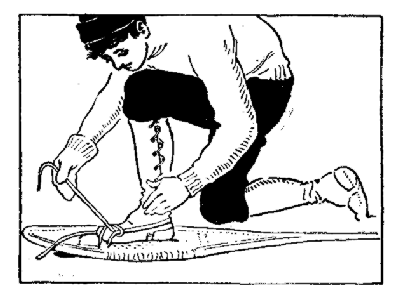 Then across the toe with both ends and under the loop
Then across the toe with both ends and under the loop Ski-running is simply coasting down steep inclines on the snow with the skis used in much the same way as a sled. The longer they are the greater the speed obtained, but the longer ones are also correspondingly hard to manage.
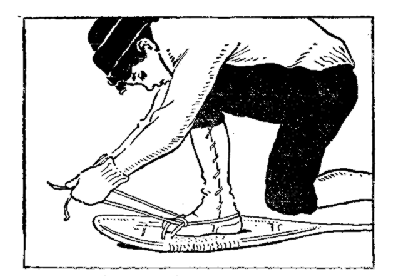 Draw the ends tightly forward to fasten down the toe
Draw the ends tightly forward to fasten down the toe  Then tie the ends together in a bow knot back of the
heel
Then tie the ends together in a bow knot back of the
heel In Norway and Sweden skis are made to order just as we might be measured for suits of clothes. The theory is that the proper length of ski will be such that the user, can, when standing erect and reaching above his head, just crook his forefinger over it as it stands upright. Ski shoes should be strong, with well blocked toes. A pair of heavy school shoes are just the thing if well made.
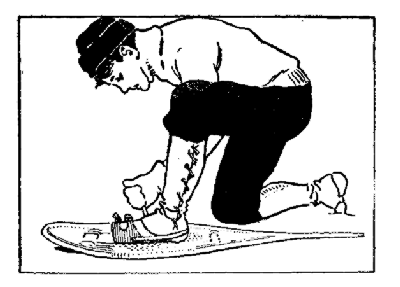 The straps over the toe remain buckled
The straps over the toe remain buckled 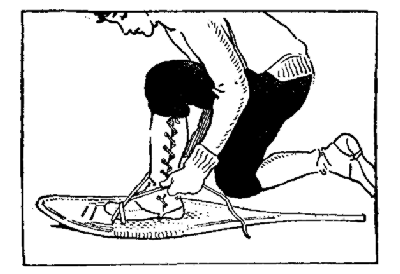 This is the "thong" hitch but it is not as good as the
lumberman's hitch
This is the "thong" hitch but it is not as good as the
lumberman's hitch To learn skiing we should select the slope of a hill not very steep and with no dangerous rocks or snags to run foul of. The best snow conditions are usually found two or three days after it has fallen. Fresh snow is too light to offer good skiing and snow with a crust is also bad. In running with skis on the level ground a long, sweeping stride is used somewhat after the fashion of skating. The strokes should be made just as long as possible, and the skis kept close together. In going up an incline the tendency to slip backward is overcome by raising the toe of the ski slightly and bringing the heel down sharply. One foot should be firmly implanted before the other is moved. In going up a steep hill a zigzag course will be necessary.
 Front and side view of a ski
Front and side view of a ski As an aid in ski-running it is customary to employ a pair of ski poles, which are fastened to the wrist by leather thongs. They are usually made of bamboo or other light material with a wicker disk near the end to keep the pole from sinking into the soft snow. Ski poles should never be used in attempting a jump, as under these circumstances they might be very dangerous.
Ski coasting is the sport that most boys will be interested in. To make a descent, begin at the top of a hill as one would in coasting with a sled and lean well forward with the skis parallel and with one foot slightly ahead of the other. The knees should be bent and the body rigid. The weight should be borne by the ball of the foot that is behind. As the start forward begins, the impulse will be to lean back, but this Impulse must be overcome or you will take a tumble in the snow as you gain speed.
 A ski pole
A ski pole In jumping with skis an abrupt drop is necessary. For the beginner a few inches is sufficient. The start is made by coasting down an incline, and just before the take-off is reached, the runner assumes a crouching attitude and then straightens up quickly, maintaining an erect attitude until he is about to land, when, as in jumping, the knees are bent slightly to break the force of landing. During the flight the skis should be kept perfectly parallel but drooping slightly behind.
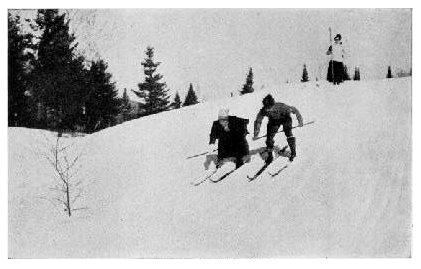 The Exciting Sport of Ski Running
The Exciting Sport of Ski Running The various forms of coasting with toboggan sleds and bobsleds are all well known to boys who live where there are snow and hills. A sled can be steered either by dragging the foot or by shifting the sled with the hands. Sleds with flexible runners have recently been introduced and are a great improvement on the old type.
One branch of carpenter work that nearly all boys attempt at some time in their lives is to make a bobsled or double runner, which is a pair of sleds fastened on either end of a board long enough to hold from three to twenty or thirty people.
 A bobsled or double runner
A bobsled or double runner Coasting, especially with a bob, is somewhat dangerous sport, especially in cities or where the turns are sharp and there is danger of upsetting. A good bob is broad between the runners and low to the ground. The drawing shows one that almost any boy can make at little cost. Various devices are used as brakes on a bob. Most of them are found to be out of order or frozen when the time comes to use them. A brake that is made from a piece of iron bent in an angle and fastened to the side of the runners on the rear sled is the best arrangement to have. A bobsled should not cost over ten dollars complete with steering wheel, bell, and necessary iron work, which should be made at the blacksmith's.
Comments
Camping Resources
Free Services
Free Text MessagesFree Picture Messages
Free Fax
Free Calls Anywhere